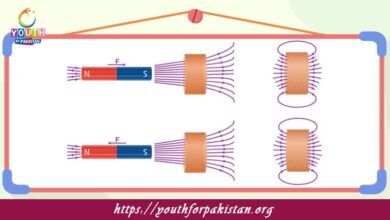Newton’s Third Law Of Motion MDCAT MCQs with Answers

Welcome to the Newton’s Third Law Of Motion MDCAT MCQs with Answers. In this post, we have shared Newton’s Third Law Of Motion Multiple Choice Questions and Answers for PMC MDCAT 2024. Each question in MDCAT Physics offers a chance to enhance your knowledge regarding Newton’s Third Law Of Motion MCQs in this MDCAT Online Test.
Newton’s Third Law Of Motion MDCAT MCQs Test Preparations
Newton’s Third Law of Motion states that:
a) An object in motion stays in motion unless acted upon by an external force
b) For every action, there is an equal and opposite reaction
c) Force equals mass times acceleration
d) Energy cannot be created or destroyed
When you push a wall, the wall pushes back with a force that is:
a) Greater than your force
b) Less than your force
c) Equal in magnitude and opposite in direction to your force
d) Unrelated to your force
If you jump off a boat, the boat moves backward. This is an example of:
a) Newton’s First Law
b) Newton’s Second Law
c) Newton’s Third Law
d) Law of Conservation of Momentum
Two ice skaters push off each other. The force they exert on each other is:
a) Different in magnitude but opposite in direction
b) Equal in magnitude and opposite in direction
c) Equal in magnitude but not opposite in direction
d) Unrelated in magnitude and direction
When a bird flies, it pushes air downward. According to Newton’s Third Law, the air pushes:
a) Upward on the bird
b) Downward on the bird
c) Forward on the bird
d) Backward on the bird
A rocket moves forward by:
a) Pushing against the ground
b) Expelling gases backward
c) Using magnetic forces
d) Increasing its mass
A book resting on a table experiences:
a) No forces
b) A force from the book pushing down and a reaction force from the table pushing up
c) A force from the table pushing down and a reaction force from the book pushing up
d) A force from the table pushing down and an equal force from the table pushing sideways
If you push against a wall with 50 N of force, the wall exerts a force of:
a) 50 N in the same direction
b) 50 N in the opposite direction
c) Less than 50 N in the opposite direction
d) More than 50 N in the same direction
When you walk, you push backward on the ground. The ground pushes you forward. This demonstrates:
a) Newton’s First Law
b) Newton’s Second Law
c) Newton’s Third Law
d) Law of Universal Gravitation
A hammer exerts a force on a nail. According to Newton’s Third Law, the nail exerts a force on the hammer that is:
a) Smaller in magnitude
b) Larger in magnitude
c) Equal in magnitude and opposite in direction
d) Equal in magnitude and in the same direction
When a car accelerates, the tires push backward on the road. The road pushes:
a) Forward on the tires
b) Backward on the tires
c) Upward on the tires
d) Downward on the tires
Newton’s Third Law of Motion can be used to explain:
a) How objects stay in motion
b) How objects accelerate
c) How forces are balanced
d) How action and reaction forces are related
When a swimmer pushes the water backward, the water:
a) Pushes the swimmer backward
b) Pushes the swimmer forward
c) Has no effect on the swimmer
d) Pulls the swimmer sideways
An astronaut in space throws a ball. The astronaut:
a) Moves away from the ball
b) Moves toward the ball
c) Remains stationary
d) Moves in the direction of the ball
In a collision between two objects, the forces they exert on each other are:
a) Different in magnitude and opposite in direction
b) Equal in magnitude and in the same direction
c) Equal in magnitude and opposite in direction
d) Different in magnitude and direction
When you jump off a diving board, the board pushes you:
a) Upward with a force equal to the force you exert downward
b) Downward with a force equal to the force you exert upward
c) Upward with a greater force than the force you exert downward
d) Sideways with a force equal to the force you exert
In a tug-of-war game, if both teams pull with the same force, the rope:
a) Stays stationary
b) Moves in the direction of the stronger team
c) Breaks
d) Moves sideways
A person pushes a cart with a force of 100 N. The cart pushes back with a force of:
a) 50 N
b) 75 N
c) 100 N
d) 200 N
In an action-reaction pair, the action force is:
a) Equal and opposite to the reaction force
b) Larger than the reaction force
c) Smaller than the reaction force
d) Unrelated to the reaction force
A car crash demonstrates Newton’s Third Law by showing that:
a) Both cars exert equal and opposite forces on each other
b) Only one car exerts a force on the other
c) The forces are not equal
d) The car with more mass exerts a larger force
A person standing on a boat exerts a force on the boat. The boat:
a) Does not respond
b) Exerts a force on the person in the opposite direction
c) Exerts a force on the person in the same direction
d) Exerts a force equal to the weight of the person
When you hit a baseball with a bat, the force of the bat on the ball is:
a) Greater than the force of the ball on the bat
b) Equal in magnitude but opposite in direction to the force of the ball on the bat
c) Smaller than the force of the ball on the bat
d) Unrelated to the force of the ball on the bat
A car accelerates forward. The force it exerts on the road is:
a) In the same direction as its acceleration
b) Opposite in direction to its acceleration
c) Perpendicular to its acceleration
d) Unrelated to its acceleration
In free fall, the Earth pulls on an object with gravitational force. The object pulls on the Earth with:
a) A smaller force
b) A larger force
c) The same force
d) No force
A bullet is fired from a gun. The gun experiences:
a) A smaller force than the bullet
b) A larger force than the bullet
c) The same force as the bullet
d) No force
When a person is sitting in a chair, the chair exerts a force:
a) Upward on the person
b) Downward on the person
c) Forward on the person
d) Backward on the person
A jet plane moves forward because the engines:
a) Push air backward
b) Push air forward
c) Push the ground backward
d) Push the ground forward
If you push a box with a force of 200 N to the right, the box exerts a force of:
a) 200 N to the right on you
b) 200 N to the left on you
c) 100 N to the right on you
d) 100 N to the left on you
A person is walking and exerts a force on the ground. According to Newton’s Third Law, the ground exerts a force:
a) Backward on the person
b) Forward on the person
c) Upward on the person
d) Downward on the person
When you pull a sled across the snow, the snow pulls back on the sled with a force that:
a) Is greater than your pulling force
b) Is less than your pulling force
c) Is equal and opposite to your pulling force
d) Is in the same direction as your pulling force
Newton’s Third Law is essential for understanding:
a) How friction works
b) How gravity acts
c) How forces interact in pairs
d) How energy is conserved
When a swimmer dives off a diving board, the board:
a) Pushes the swimmer with a force equal to the force exerted by the swimmer
b) Pushes the swimmer with a force less than the force exerted by the swimmer
c) Pushes the swimmer with a force greater than the force exerted by the swimmer
d) Does not push back on the swimmer
If a car and a truck collide, the force exerted on each vehicle is:
a) Different in magnitude
b) Equal in magnitude but opposite in direction
c) Different in direction
d) Unrelated
A person jumping off a platform will experience a force from the platform that is:
a) Larger than the force of gravity
b) Equal and opposite to the force of gravity
c) Smaller than the force of gravity
d) Unrelated to the force of gravity
A horse pulls on a cart with a force of 500 N. The cart pulls on the horse with a force of:
a) 500 N in the same direction
b) 500 N in the opposite direction
c) Less than 500 N
d) More than 500 N
When you push a book across a table, the book:
a) Exerts no force on the table
b) Exerts a force on the table in the opposite direction
c) Exerts a force on the table in the same direction
d) Exerts a greater force than the force you apply
When a person jumps off a boat, the person exerts a force on the boat. The boat:
a) Moves toward the person
b) Remains stationary
c) Moves away from the person
d) Sinks
A balloon moves upward when air is released because the air:
a) Pushes the balloon downward
b) Pushes the balloon upward with equal force
c) Pushes the balloon upward with greater force
d) Does not affect the balloon
In a tug-of-war, if one team pulls with a force of 800 N, the opposing team:
a) Pulls with a force of less than 800 N
b) Pulls with a force of equal to 800 N
c) Pulls with a force of more than 800 N
d) Does not exert any force
If a car exerts a force of 2000 N on a trailer, the trailer exerts a force of:
a) 1000 N on the car
b) 2000 N on the car
c) 3000 N on the car
d) 0 N on the car
If you are interested to enhance your knowledge regarding Physics, Chemistry, Computer, and Biology please click on the link of each category, you will be redirected to dedicated website for each category.





